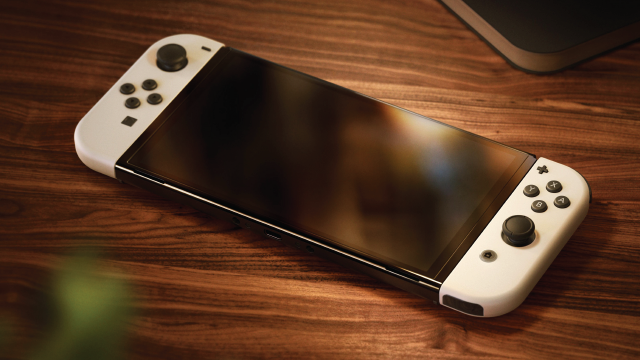At a glance, Nintendo Switch OLED Model doesn’t seem to be much of a leap from the baseline version of the console that launched back in 2017. It uses the same Joy-Con (including the vulnerability for Joy-Con drift), there’s no difference in processing power, and it still outputs games on a TV screen at the same 1080p resolution as its predecessor. What, then, makes OLED worth a look? It’s all in the name: that OLED screen. But it’s also a menagerie of other additions and tweaks that make this the superior Switch hardware.
What it boils down to above all else is that OLED allows Switch to realize its full potential as a portable console. I don’t think anyone would argue that Nintendo didn’t nail TV Mode, and with roughly half of users playing in Handheld Mode it also isn’t likely that anyone would say Switch fails as a portable system. However, after playing with the OLED iteration of the hardware for over a week, what I’ve come to find is that in comparison, a baseline Switch is lacking. All of the new features and revisions make this the better console.
The biggest alteration is the 7-inch OLED screen. OLED, or Organic Light-Emitting Diode, screens provide vivid, crisp picture quality superior to a standard LED. From the moment I booted up my OLED Model it was clear (no pun intended) that the visuals were better than what I was used to with my original Switch. Although the 720p resolution is exactly the same as a stock Switch, OLED screens output light differently. This means that blacks are darker and colors are much brighter and more brilliant than anything an original Switch or Switch Lite can produce. This is hands-down the best screen of the bunch.
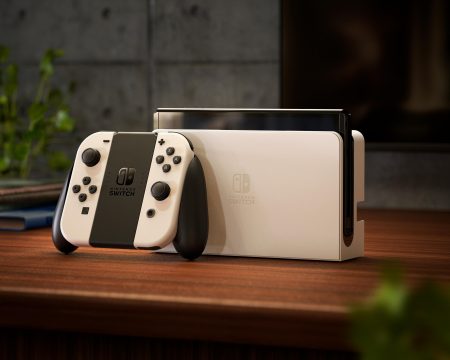
Second, the audio is much improved. The speakers have been slightly repositioned at the base of the console, making them easier to hear when played in Tabletop Mode. Sound quality itself is better, with a notable uptick in bass and treble capabilities. The result is richer sound without having to pop in headphones. I was surprised how clearly I could hear my OLED even in a loud place like the inside of a restaurant. For those who wished Switch had more robust audio, OLED has you covered.
Third, the console’s build has a more luxurious vibe than a standard Switch. The face of an OLED has a smooth finish, while the back remains matte. The feeling in the hands is one of premium quality. I don’t think it’s a coincidence that PS5 is rocking white and, lo and behold, here comes OLED doing the same (you can get a black dock with the Neon Red and Blue Joy-Con if you prefer), but it really works. As innocuous as a colorway might seem, it makes OLED stand out and feel “new.” It does seem more fingerprint prone than a baseline Switch, but that’s a small irritant at best—and nothing a good microfiber cloth can’t blast away in an instant.
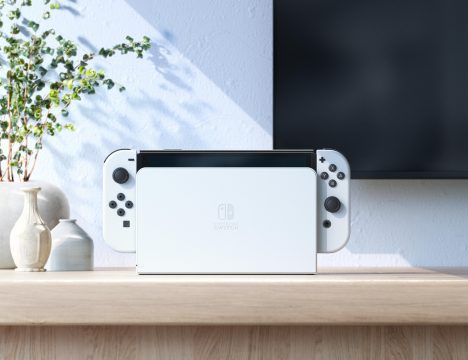
The dock, meanwhile, boasts cleaner, rounded lines, but the changes aren’t just cosmetic. It also now has a wired LAN connection, which can be found on the inside of the unit behind the cover. This comes at the cost of a USB port, but anyone who already owned a LAN adapter for their original Switch dock isn’t likely to complain. However, given that a strong WiFi connection can sometimes render a wired connection moot depending on a player’s needs, it might sadden some to see that third USB go by the wayside. Especially for those who don’t have their console anywhere near their router. Still, as someone who has an awful Internet connection at home, I was happy to see a proper LAN port.
The dock also sports better grip thanks to a new rubber base, and the interior of the dock is now glossy as opposed to matte, which should reduce the potential for screen scratching. The panel that opens up the back of the dock is no longer hinged—it simply pops off, which will hopefully prevent any accidental breaks. There’s also a larger ventilation hole to help keep your Switch nice and cool while playing games. One final note on the dock is that it’s now capable of outputting a 4K picture resolution (but does not currently because the OLED Model can’t produce the needed signal). This has many pundits convinced that Nintendo is indeed planning to release a more powerful Switch model. That didn’t impact my purchasing decision, but it might potentially impact yours, although this is all wholly speculation.
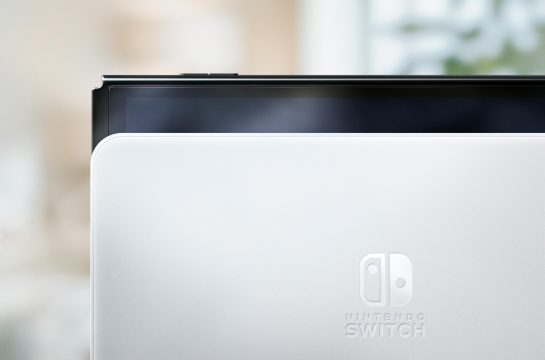
The elephant in the room when it comes to OLED is, should consumers buy it if they already own an original Switch? To be frank, no one who already owns a Switch needs an OLED. The OLED’s changes don’t make the older models of Switch or Switch Lite obsolete. That said, anyone who has yet to buy a Switch should absolutely buy this version because it is undeniably superior. I would also wager that many current Switch owners might feel a strong urge to upgrade to an OLED after getting some hands-on time with one. OLED isn’t the new, more powerful Switch that some fans have been clamoring for, but it easily justifies its existence thanks to smart design choices and quality of life improvements.
Thoughts on the Nintendo Switch Carrying Case & Official Screen Protector
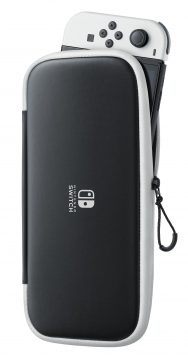
In case you hadn’t heard, Nintendo has been warning consumers not to remove the clear film that goes over the OLED’s screen. It’s meant to protect users in the case that the glass shatters and dislodges from the console, which could potentially cause harm. The included screen protector isn’t glass, which is what I usually prefer, but given the more delicate screen of the OLED Model, I opted to get Nintendo’s official protector. It went on very easily, which I’m not used to with non-glass screen protectors. It also comes with a protector for a standard Switch, too, which is… odd, but a nice bonus regardless. Consider spending the $20 to get one if you decide to buy an OLED Model.




 ShareThis
ShareThis